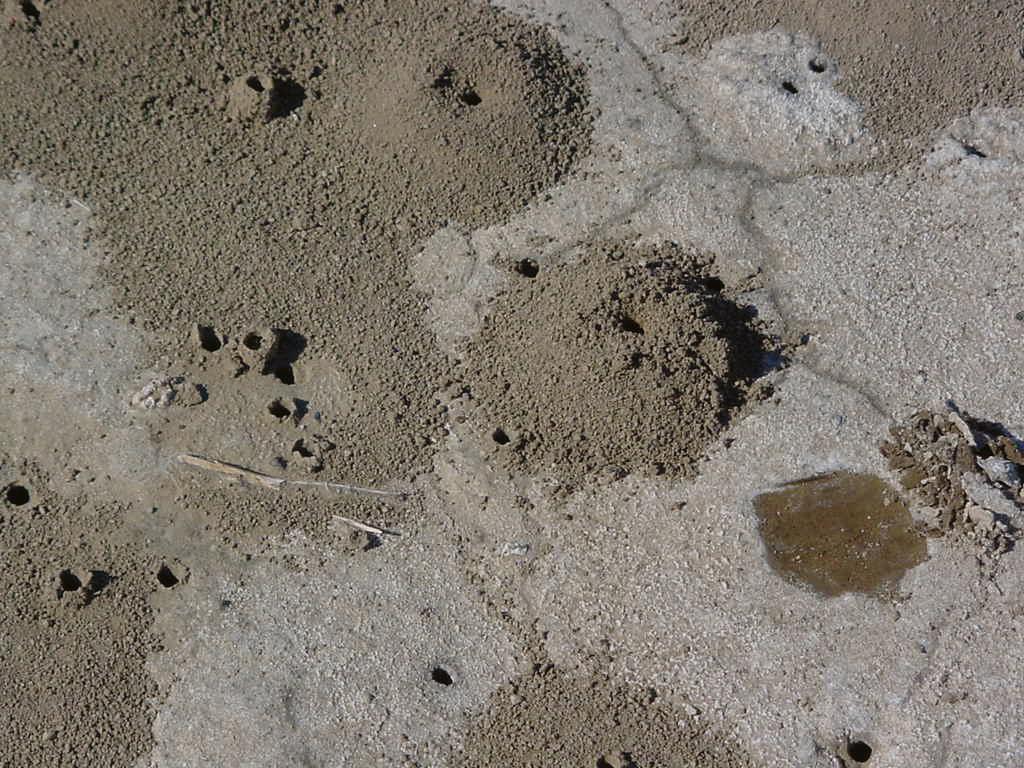
(Nomia melanderi)
Along with the alfalfa leafcutter bee (see Chapter 7), alfalfa seed production in the US has historically been linked to the alkali bee (Nomia melanderi), a ground-nesting bee native to arid regions in the western US. The alkali bee’s affinity for alfalfa blossoms (see sidebar: Alfalfa Pollination) was first recognized by forage producers in the 1940s. Following the development of management techniques in the late 1950s, growers using the alkali bee have produced astounding yields of up to 2,400 pounds of cleaned seed per acre (~2,700 kilograms per hectare)—this in the normally unproductive desert regions of the Great Basin. Interest in the alkali bee declined in the late 1960s and 1970s due to rising interest in alfalfa leafcutter bees. Managed populations also suffered in many areas during this time after several seasons of heavy rainfall, which led to mold spoilage of previously productive nest sites.
Because they are ground nesters, alkali bees cannot be easily transported, and their usefulness is confined to arid locations where flooding is rare—typically flat alkaline desert soils. Within these playas or “salt flats,” individual bee nests are usually located in the upper 8 inches (~20 centimeters) of soil and consist of tunnel entrances with a series of brood chambers located below the surface (Figure 8.1).
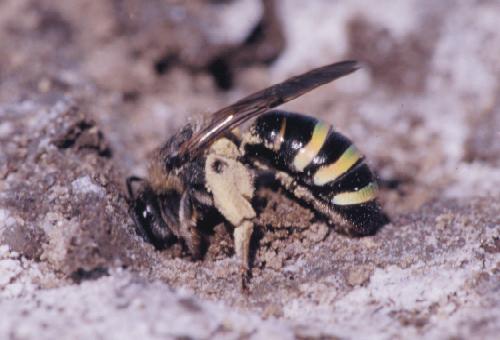
Most recently, the alkali bee has been employed for pollination of other crops including sweet clover, mint, onion, and celery. Alkali bees are currently the only managed soil-nesting bee in North America— a surprising fact given that the vast majority of bee species nest below ground.
To achieve adequate pollination, crops must be located within 5 miles (8 kilometers) of a nest site. Where naturally occurring nest sites are rare, artificial nests can be constructed. This process can be labor intensive and may require the use of finely ground rock salt or table salt (NaCl) as a soil amendment.
Life Cycle
Alkali bees are members of the Halictidae family, which includes a diverse array of other solitary ground-nesting species—often called “sweat bees” for their occasional attraction to the salt present in human perspiration. Alkali bees average 7/16 inch (11 millimeters) in length and are generally dark colored with iridescent gold or green bands on the abdomen (Figure 8.2). Male bees are distinguished by their longer antennae and lack of stinger.
Like alfalfa leafcutter bees and mason bees, the alkali bee is a solitary species. Individual females construct and provision their own nests, and have no contact with other female bees. However, like other managed solitary bees, the alkali bee is gregarious and nests in close proximity to others of its own kind.
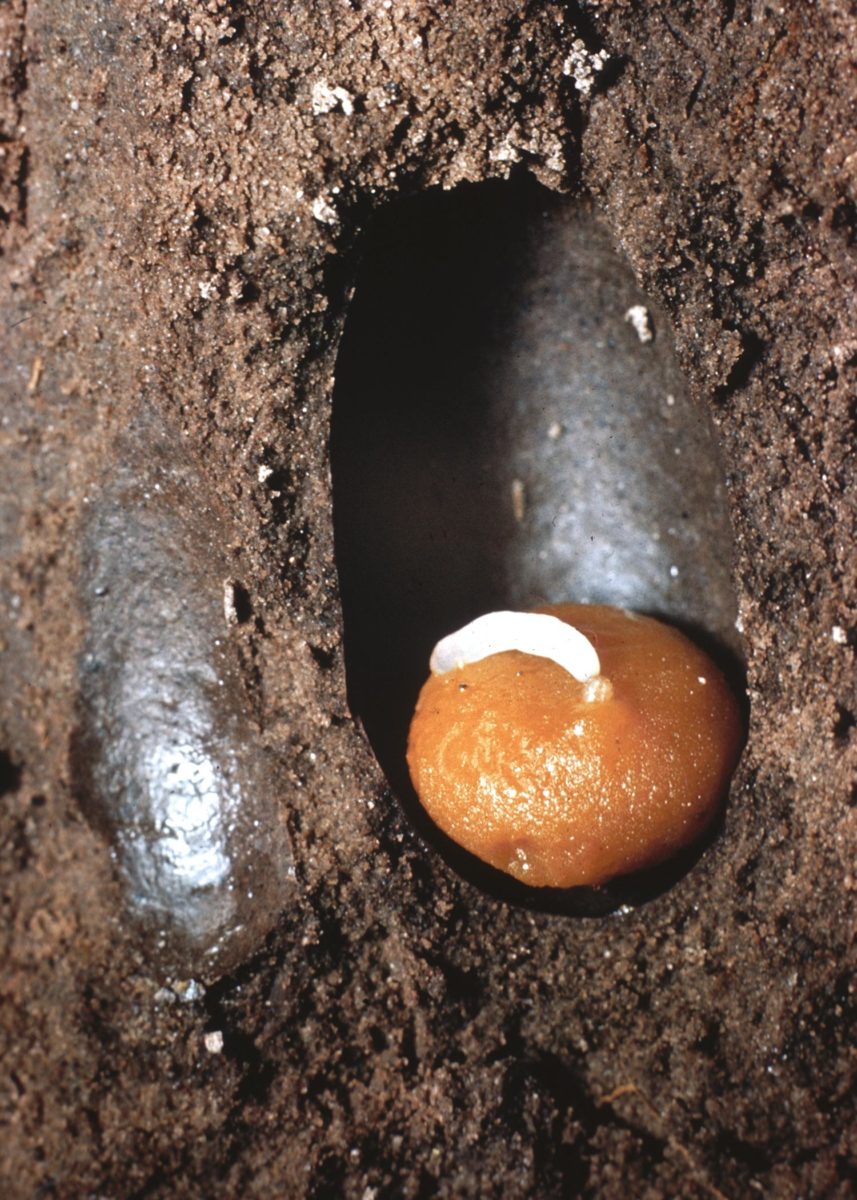
Nests are constructed in the crusted-over soils of wet alkali flats. In these areas, capillary action from high water tables brings salt and minerals to the surface where crystals are deposited as the water evaporates. These minerals form a thin crust limiting further evaporation and maintaining a moist nesting environment in the otherwise arid region of the bee’s native range. Under optimal conditions 1 cubic foot (28.3 liters) of alkaline soil may contain up to 50 nest cells.
Individual nests consist of a single vertical tunnel slightly less than 1⁄2 inch (12.7 millimeters) in diameter, from 3 inches to 16 inches deep (7.6 to 41 centimeters). Short oval-shaped cavities branch off from the main entrance tunnel, resulting in a series of individual cells about 1⁄2 inch in length (figure 8.3). Within an individual nest there may be up to 15 or 20 of these smaller cells. These cells are provisioned with a sticky mixture of pollen and nectar formed into balls by the nesting female. Typically eight to ten separate foraging trips are required to collect the necessary pollen.
An egg is laid on top of the pollen ball (Figure 8.4) and it hatches within three days. As with other bees, female alkali bees control the sex of their offspring by laying a fertilized egg, which develops into a female bee—or by laying an unfertilized egg, which develops into a male.
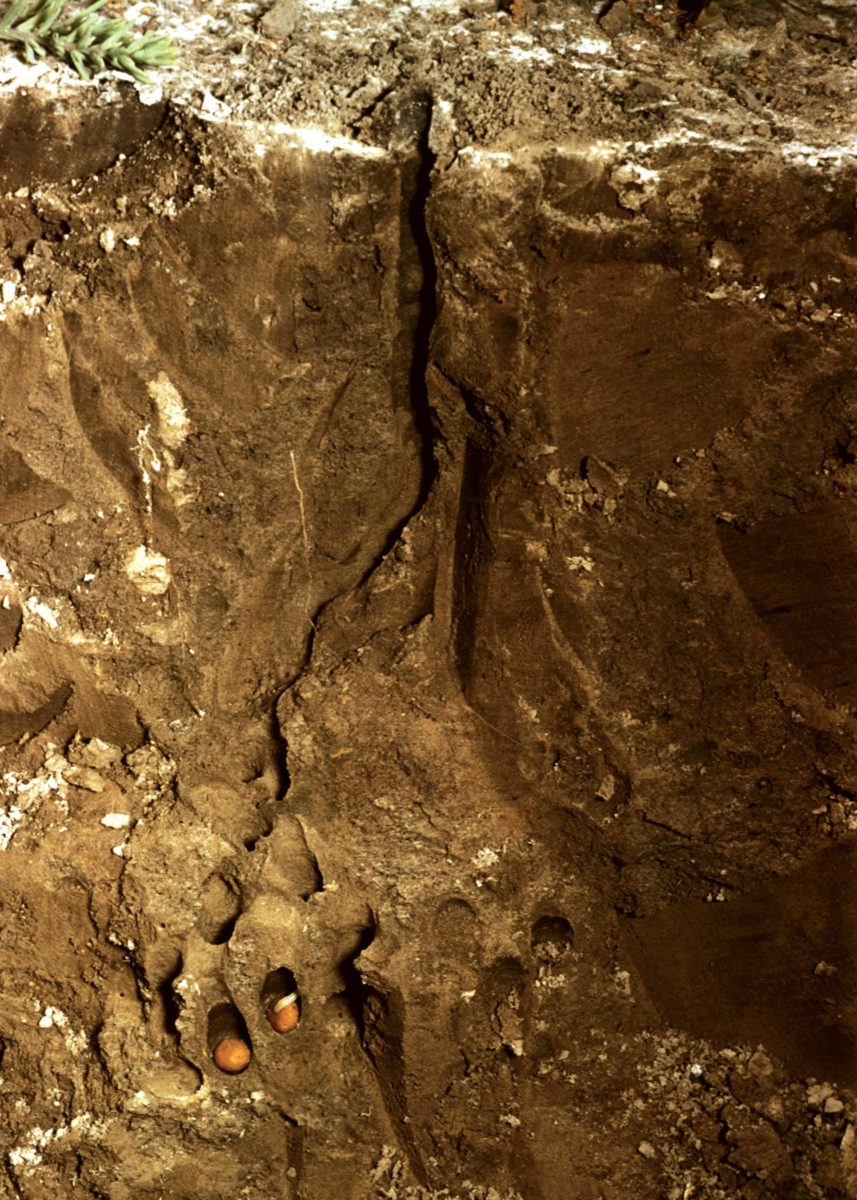
Over the next eight days the young larva grows until reaching its full size and then remains dormant as a full sized larva for up to ten months—typically over the winter. The following summer the larva undergoes pupation, changing into a recognizable tunnel, with the soil that is removed being deposited around the entrance hole in a conical mound 2 to 3 inches across (5.1 to 7.6 centimeters) (resembling an ant hill, but with a larger entrance). As the tunnel and individual cells are excavated, the nesting female applies a transparent secretion from her tongue to the tunnel walls. This secretion forms a waterproof cement, which maintains the structural integrity of the walls and prevents flooding. Individual cells are also sealed off with a soil plug made from tunnel soil excavations during the nesting process. About one cell is completed each day.
Mating occurs immediately upon female emergence, which is normally preceded a day or two earlier by male emergence. Males patrol over the nesting area and pounce on females as they emerge from the ground. A single male may mate with multiple females. After mating, the female bee will live for approximately one month. During that time she will normally construct a single nest tunnel containing up to 20 cells.
Artificial Nest Sites
Because of its selective nesting requirements, the alkali bee is susceptible to habitat loss and now is uncommon in parts of its original range. In fact the early success of the alkali bee has contributed to its decline in some areas as growers expanded field sizes to take advantage of abundant local bee populations, often plowing up productive nest areas in the process. In other areas, off-road vehicle traffic and cattle grazing have resulted in extensive habitat loss. However, artificially constructed soil beds continue to provide some habitat in the alfalfa seed production regions of the Great Basin and Pacific Northwest.
These artificial beds typically consist of an excavated trench, usually two to three feet deep, which is then lined with a pond liner, thick plastic sheeting or an impermeable layer of bentonite clay. If a plastic liner is used, it should be covered with a layer of straw or soil to protect against punctures. Next a 5-inch (12.7-centimeter) layer of gravel is added to the bed. Above this initial gravel layer, vertical standpipes are installed roughly 50 feet (~15 meters) apart with perforated drain pipes radiating outward throughout the gravel layer. Above these drain pipes an additional 5 inches (12.7 centimeters) of gravel is added, and covered with straw, burlap, or landscape fabric to prevent soil infiltration of the gravel layer. Finally the soil is backfilled over the bed and lightly compacted. When finished the bed should be slightly elevated so that rain water does not pool on top of the nest site.
Artificial beds of this type should ideally be constructed in silty loam soils with no more than seven percent clay. As water is added to the standpipes, moisture will rise to the surface and should create a firm layer of salt, which seals in soil moisture and slows further evaporation of water from the bed. If the soil is not adequately saline, salt can be mixed with water and added to the standpipes. More commonly, salt is often applied to the surface at a rate of 1 pound per square foot (~5 kilograms per square meter) and raked into the upper 2 inches (5 centimeters) of soil.
The final result is a standing water reservoir below ground with a constant supply of moisture extending upward to a crusted-over surface which reduces evaporation. Maintaining this soil moisture consistently between 8 and 35 percent in the upper layer of the bed where bees are actively nesting is critical. Soil tensiometers provide a quick and easy moisture measurement, and, as necessary, water can be added to the standpipes. If excessive soil drying becomes a problem during the nesting season, bee beds can be shaded with either nursery shade cloth or military surplus camouflage netting suspended above the bed on permanent posts.
Alkali bees may find the artificial bed if other natural or managed nest sites are located within a mile or so. Often however, the bed may have to be stocked with bees, either as adults, or as larvae, acquired from other growers. Dormant larvae are typically installed into the bed as 1 cubic foot (0.028 cubic meters) blocks of undisturbed soil from established beds. This is normally performed during the winter when the larvae are inactive. Such soil blocks may contain more than 50 larvae.
Adult bees may also be released at the new nest site; however, results may not be as successful, especially if the bees were collected within 10 miles (16 kilometers) of the new bed. Adult bees are typically stocked by collecting them with insect nets at established beds and releasing them at the new bed after dark. Small holes are often punched into the bed with a pitchfork to encourage the released bees to remain at the new site.
There is little published information regarding optimal bed size for managed alkali bee populations. The general consensus among alfalfa growers seems to be the larger the better. Beds of around an acre (0.40 hectare) in size may produce thousands, or even millions of bees. In fact in some areas, growers’ cooperatives manage these sorts of community beds, and since alkali bees may forage up to 5 miles (8 kilometers) or more, they provide pollination services for multiple farms. The drawback with such large beds is that bees traveling greater distances have the potential for increased pesticide exposure in densely cultivated regions. Where conditions can support these sorts of bee beds, the initial installation and ongoing maintenance costs are a bargain compared to annual honey bee rental or purchased leafcutter bees.
Individually, a female alkali bee begins foraging an hour or two after sunrise and continues until an hour or two before sunset. She may average a pollination rate of 12 alfalfa flowers per minute, or around 2,000 flowers per day. In the one month of her active adult life, a female alkali bee may pollinate up to 25,000 flowers, resulting in up to a third of a pound of alfalfa seed. As with most other bee species, male alkali bees visit flowers for nectar only and are not considered effective pollinators.
Additional Management Practices
In natural settings, the alkali bee forages on common scrubland plants like Russian thistle, greasewood, cleome, locoweed, and morning glory. Even among managed populations, these wild plants are important supplemental food sources and should be allowed to grow as an alternate food source when the main crop is not in bloom. Bee populations without adequate forage sources throughout their nesting period are likely to decline after several seasons.
In addition to alternate forage sources, both natural and artificial bee beds should be fenced off to prevent vehicle traffic and livestock trampling where necessary. Beds should be kept free of weeds to maintain an attractive bare surface. Beds should not be flooded during the active nesting season if possible.
Pesticide use should be reduced or eliminated during the nesting period, and blooming plants should not be sprayed at all while alkali bees are active. For more information on reducing bee losses to pesticides, see Appendix D.
As with other solitary managed bees, the female alkali bee has a stinger but rarely uses it. Protective clothing, such as bee suits and veils used for honey beekeeping, is unnecessary when working around alkali bees.
Parasites and Diseases
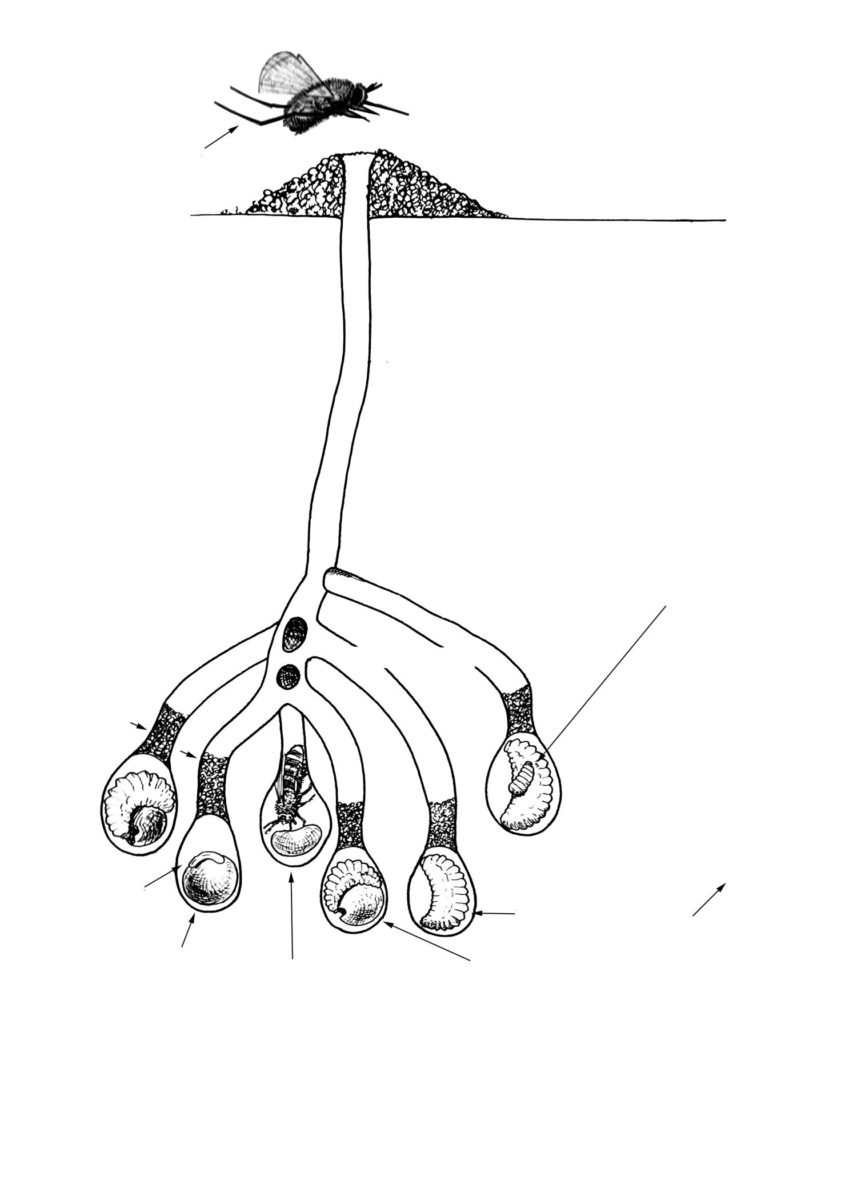
Alkali bees are attacked by a number of parasites and diseases; however as with other management aspects for this species, little research has been performed. Among the most notable pests are the bomber flies (Heterostylum robustum), and the black blister beetle (Meloe nigra). The larvae of both species feed on the developing alkali bee larvae. The bomber flies are notable for depositing their eggs into bee nests while hovering above tunnel entrances (Figure 8.5). The egg soon hatches and the fly maggot burrows into a cell containing the developing bee, which it devours. Female blister beetles on the other hand crawl directly into nest entrances and lay their eggs in a suitable cell. Developing beetle larvae consume both the pollen-nectar provision and the developing bee.
Other reported pests of alkali bee larvae include the flesh fly (Euphytomina nomivora), the thickheaded fly (Zondion obliquefasciatum), various ambush bugs, tiger beetles, checkered flower beetles, chalcid wasps, ants, spiders, mites, and cuckoo bees, which kill the alkali bee larvae, and consume their food provisions. Larger animals such as birds, rodents, and skunks may also prey upon both immature and adult alkali bees.
In addition, various bacterial, fungal, and possibly viral pathogens may attack developing larvae. Food provisions are also prone to spoilage by yeasts and molds under wet conditions. As with animal pests, few established control measures exist for diseases.
